There are the changes described in organism poisoned by nitrosodimethylaminum in this article. During the intoxication by nitrosodimethylaminum had been determined changes in the function of the liver, buds, heart. The full biochemical analysis of action of a medical product on an organism of experimental animals is given.
The lab rodents` biochemical and cytological parameters under the N-nitrosodimethylamine (NDMA) action with the application of the hepatoprotector Cytofat have been researched. The received models can be successfully used in ecology and pathology areas.
Severe weakness, dysfunction of cardiovascular, respiratory systems and thermoregulation are shown under N-nitrosodimethylamine (NDMA) acute poisoning [9]. Moderate changes of protein, carbohydrate and other kinds of metabolism are also observed. Peripheral blood is characterized by transit leucopenia following by leukocytosis; thrombocytopenia, tendency to anemia [4]. In liver cytochrom P-450 is replaced by nonactive P-420 form. [3]. Sever protein and carbohydrate dystrophy of hepatocytes with necrobiosis and centrobular necrosis development, proteinbuilding and carbohydrate function suppression, nuclear metabolism dysfunction, and further — liver fibrosis and chronic hepatitis development are morphologically shown [1, 2, 5, 11]. According to some authors` results, oxidative and hepato-toxic effects of NDMA are more seen under the moderate dozes of toxicant and their doubling rather than one big doze using [2]. Acute toxic necrosis with the nephritic component, membrane or serologic glomerulonephritis are observed in kidneys [8, 10].
Significant circulator dysfunctions, protein dystrophy signals are observed in myocardium [6]. Increased level of vascular penetration is observed in all internal organs [7, 9].
The progressive liver insufficiency symptoms (dysfunction of protein, carbohydrate and pigment metabolism) are the characteristics of the chronic intoxication. The other (less shown) symptoms are: kidney insufficiency and decreasing of some hematology indexes. Chronic hepatitis (following by the cirrhosis), chronic nephrosonephritis, sometimes membrane glomerulonephritis are morphologically observed [1].
The analysis of cytological and morphological blood indexes shows the following: erythrocytes amount is 28,75 % (p <0,001) less under acute and chronic intoxication by NDMA; leucocytes amount is sufficiently higher — 81,94 % (p <0,001) in the second group of the animals; leucocytes amount is moderately higher — 30,15 % (p <0,001) in the fourth group compare to the blood parameters of control rats. After preparation Cytofat introduction leucocytes amount got close to the control data, which is an evidence of the inflammatory process decreasing. The moderate decreasing of hemoglobin — 17,12 % and decreasing of color index — 27,83 % are observed in the second group of the animals under the acute intoxication. The hemoglobin concentration and color index were not changed sufficiently in the forth and fifth groups of the animals. After preparation Cytofat introduction hemoglobin level got 16 % less but color index got back to normal. ESR is within the norm limits (Table 1).
In the second group of the tested animals the amount of stab neutrophils in differential blood count was 26,67 % (p <0,001) higher, the amount of segmented neutrophils 35,83 % (p <0,001) less, the amount of eosinophils 17,15 % (p <0,001) less, the amount of monocytes 53,57 % (p <0,001) higher, the amount of lymphocytes was not changed compare to the control data. In the forth group the amount of segmented neutrophils was 42,24 % (p <0,001) higher, the amount of eosinophils 97 % (p <0,001) higher, the amount of monocytes 264,27 % (p <0,001) higher, the amount of lymphocytes 26,52 % (p <0,01) less compare to the amount of leucocytes morphological forms of control animals blood (drawing 1).
T a b l e 1
Changes of hematology parameters under intoxication by NDMA and detoxication by Cytofat preparation
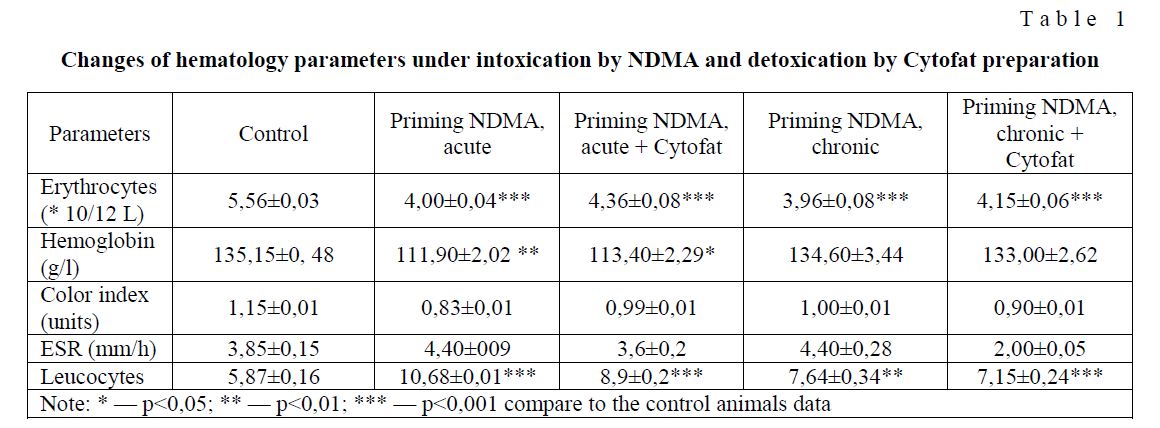
At introduction of Cytofat preparation in the third group of the animals the following blood parameters were observed: the amount of neutrophils 53,96 % higher, the amount of eosinophils10 % higher, the amount of monocytes 6,98 % less, the amount of lymphocytes 9,5 % less compare to the second group data. At introduction of Cytofat preparation the improvement of differential blood count compare to the data of затравленных groups was observed (Drawing 1).
Neutrophil leukocytosis with the deviation to the left is an evidence of intoxication acute form. Eosinopenia is the other evidence of acute damage and stress development. Relative monocytosis, most likely, is caused by the strengthening of immune reply to the intoxicant presence.

Drawing 1. The differential blood count of control rats and of rats toxicated by NDMA
Moderate leukocytosis with the neutrophilosis and nuclear deviation to the right in this group of the animals are the evidences of leukomoid reaction, caused by production increasing and leucocytes moving from bone marrow to blood. As a result, decreasing of the leucocytes amount in a bloodstream. Eosinophilia, observed in this group, might be caused by organism sensitization and slowing down form of allergy development; relative lymphocytopenia might be caused by increasing neutrophilia. Monocytosis, observed in this group animals blood, shows strengthening of the immune processes in organism.
Biochemical parameters data of the control group animals are given in the Table 2.
Biochemical parameters of control group rats blood
T a b l e 2
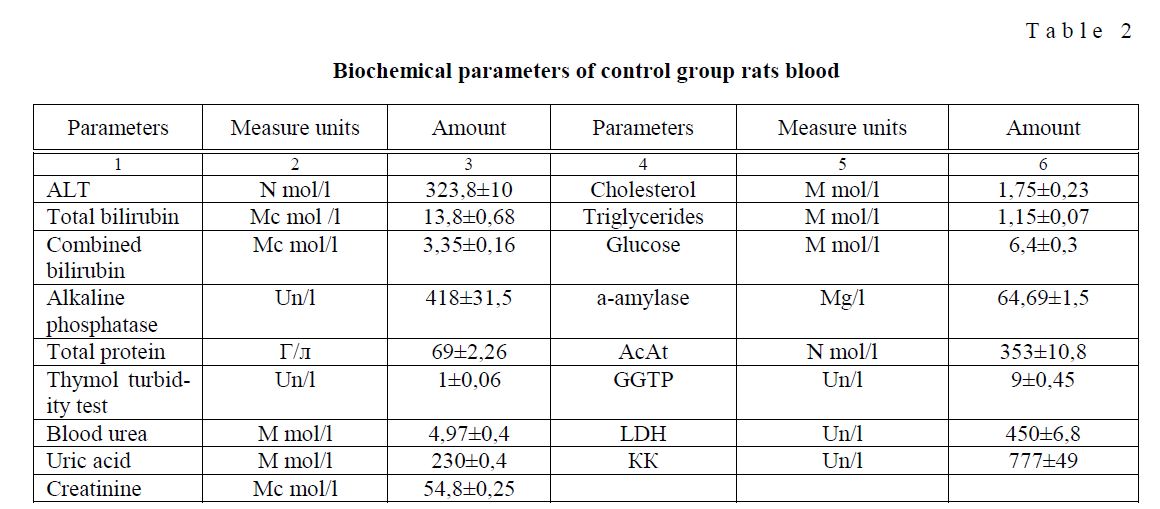
Under acute Priming, the glucose amount gets 19,59 % (p <0,001) higher, under chronic Priming by NDMA this parameter gets 99,5 % (p <0,001) higher (drawing 2), which is an evidence of carbohydrate metabolism change caused by NDMA intoxication.
As for the a-amylase activity change, it has decreased at 40,01 % (p <0,001) in the second group, and at 30,06 % (p <0,001) in the forth group, which shows the carbohydrate oxidation change with their decay in tissues slow down.
The glucose amount has increased at 12,6 % (p <0,05) in the third group, at 106,87 % (p <0,001) in the fifth group; the a-amylase amount has decreased at 38,78 % (p <0,001) in the third group, at 10,97 % in the fifth group. Cytofat application does not cause changes in blood glucose amount, but the a-amylase activity is improved compare to the priming group.
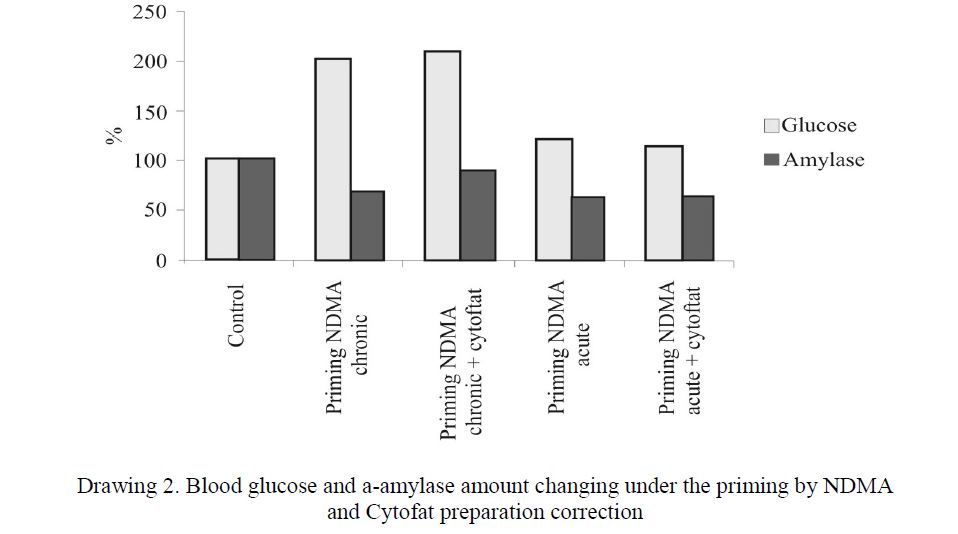
Drawing 2. Blood glucose and a-amylase amount changing under the priming by NDMA and Cytofat preparation correction
According to our researches results, NDMA (chronic priming) caused increasing of: blood triglycerides at 18 % (p <0,001), cholesterol at 36,57 % (p <0,001). This confirms the change in lipid metabolism under chronic intoxication by НДМГ products. Perhaps, this is connected to the liver function damage and the following increasing of liver lipoprotein secretion into the plasma (Drawing 3). Using hepatoprotector Cytofat has caused the increasing of: blood triglycerides at 5,47 % (p <0,001), cholesterol at 17 % (p <0,01) compare to the control data. This confirms positive effect of the preparation. Total blood protein content in plasma is increased at 42,95 % (p <0,01) in the second group, at 9,7 % in the fourth group. Thymol turbidity test has increased at 386 % (p <0,001) in the second group and was within norm limits in the forth group. Under acute Priming with the previous Cytofat using the protein level in the animals blood was 39,98 % less. Under chronic priming with the Cytofat correction it was 3,65 % higher compare to the control animals.
According to the experiments, the urea level in the fourth group of the animals receiving NDMA in a doze of 4 mg/kg, has decreased at 17,06 % (p <0,01), the significant changes were not observed in the second group. The uric acid level has increased at 9,08 % in the fourth group of the animals, in comparison with the first group data, and has remained within the limits of the control group data in the second group of the animals. The creatinine level has been changed slightly in the experimental groups only in the second group of the animals, receiving NDMA (40mg/kg), compare to the control data the creatinine level has decreased at 14,04 % (Drawing 4).
The experiments have proved, that shown moderate dysproteinemia can be explained as an initial phase of protein metabolism dysfunction under NDMA influence. Unsymmetrical dimethylhydrazines (UDMH) (1,1-Dimethylhydrazine) products action at the various ferment systems is not specific. It can cause either increase or suppression of the enzymes activity.
The mechanism of hydrazine products toxic action is based on their non-ability to inhibit of enzymes — transaminases, aminoxydases, decarboxylases and others. It leads to the phosphorilation, decarboxylation, oxidations, and other important vital processes reactions change [3].
The following changes in the enzymes activity have been found: transaminases activity in the experimental groups was authentically higher than the control data; ALT activity in the second group was 161,58 % (p <0,001) higher, and 101 % higher in the fourth group (drawing 5).

Drawing 3. Plasma triglycerides and cholesterol content changing under priming by NDMA with the correction by Cytofat
Under detoxication by Cytofat the ALT activity was 82 % (P <0,5) less in the second group and 2,25 % less in the fifth experimental group of the animals compate to the control data.
АсАТ activity was increased as well — at 58,96 % (p <0,001) in the second group of the animals, at 303,37 % (p <0,001) in the fourth group of the animals. In the third group of the animals this parameter was only 50,49 % higher and in the fifth group — 64,92 % higher compare to the control animals data.It shows that after Cytofat receiving the transaminases activity is decreasing compare to the parameters of the priming animals.
De Ritis coefficient, which shows the proportion of transaminases, is equal to 2 under chronic intoxication by NDMA and is equal to 1,6 under correction by Cytofat, which is an evidence of cardiac muscle damage because of the chronic intoxication. Under acute intoxication this coefficient is equal to 0,6 in the forth group and to 0,83 in the fifth group, which is an evidence of sever functional liver condition and acute hepatitis development. Acute hepatitis is accompanied by sharp increasing of ALT and АсАТ activity, where the АсАТ activity is increased but is usually lower than the ALT activity. The ALT activity becomes to increase at the продромальной phase, when the other signs of the disease are not shown yet. De Ritis coefficient АсАТ/ALT <1.
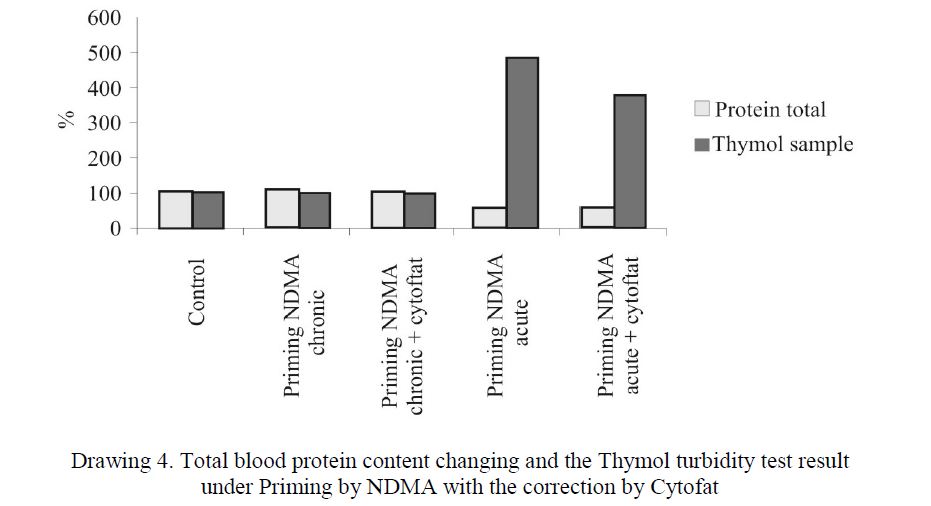
Drawing 4. Total blood protein content changing and the Thymol turbidity test result under Priming by NDMA with the correction by Cytofat
Alkaline phosphatase in the fourth group has increased at 30 %, and its change was insignificant in the fifth group (Drawing 6).
GGTP level in the fourth group of the animals was 8,9 % less, and was 10,1 % less in the fifth group. LDH and KK activity change took place under various pathological conditions, including the sever forms of intoxication [4]. After the first experiments the signs of cardiac muscle damage had been found. That is why we have carried out the research to determine above mentioned enzymes activity change in the fourth and fifth groups of the animals.
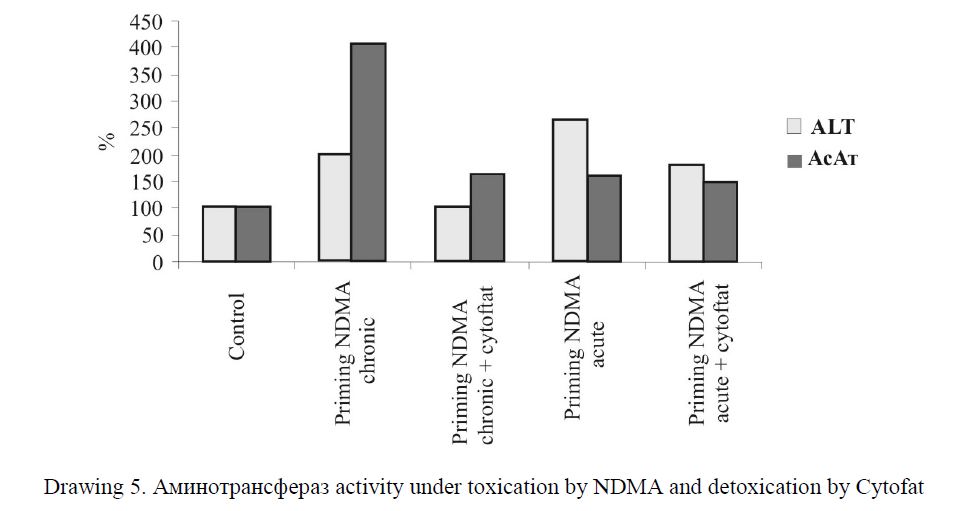
Drawing 5. Aминотрансфераз activity under toxication by NDMA and detoxication by Cytofat
According to our experimental data, LDH activity is increased at 22,53 % in the fourth group, at 11,33 % in the fifth group. KK activity in the fourth group is 27 % higher, in the fifth group — 8,6 % less compare to the control data.
It should be noted that under the chronic intoxication by NDMA the moderate changes in cardiac muscle happen, such as blood serum LDH and KK activity increasing, which show the initial stages of myocardial infarction.
Total bilirubin and combined bilirubin content in blood serum of the animals under chronic intoxication is not changed significantly, but it is changed significantly under acute intoxication: total bilirubin concentration in the second group has increased at 211,24 %, in the fourth group has decreased at 7,39 %; combined bilirubin in the second group has increased at 204,49 %, and in the fourth group has decreased at 10,45 % (p < 0,001) compare to the control data.
After Cytofat introduction total bilirubin has increased at 162,72 % (p < 0,05) in the third group and has decreased at 2,89 % in the fifth group; combined bilirubin has increased at 205,05 % (p < 0,01) in the fifth group and has decreased at 4,48 % compare to the control data level (Drawing 7).

Drawing 6. Alkaline phosphatase, LDH, KK, GGTP activity change under toxication by NDMA and detoxication by Cytofat
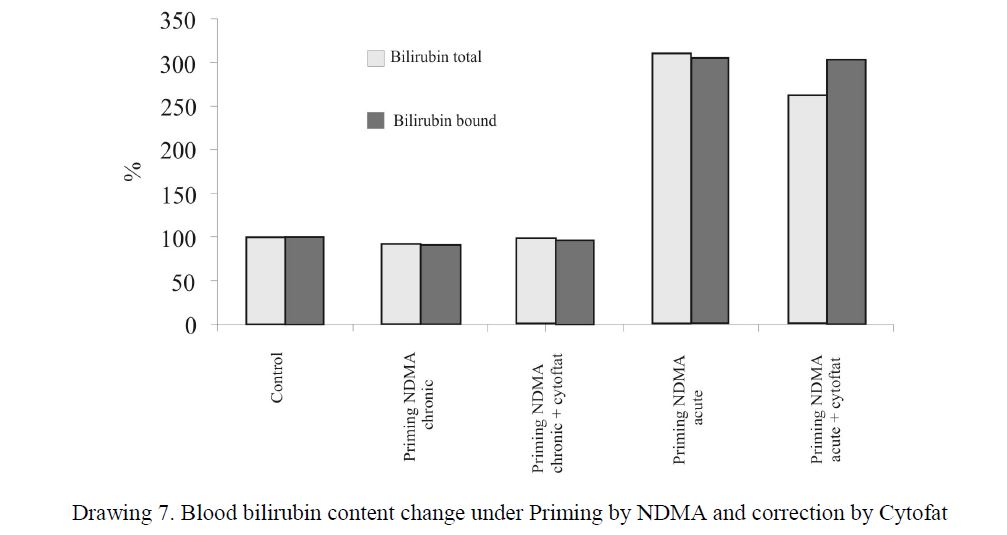
Drawing 7. Blood bilirubin content change under Priming bу NDMA and correction by Cytofat
These data confirm liver pigment metabolism damage under intoxication by NDMA, the degree of this function damage id higher under acute intoxication compare to chronic intoxication. Cytofat application as a medical remedy has normalized these parameters.
Thus, according to the biochemical blood research results, it is possible to conclude, that under acute intoxication by NDMA liver damage takes place in general, which is confirmed by transaminases activity increasing, thymol turbidity test, bilirubin in kidneys, that is also confirmed by hypoproteinemia and decreasing of creatinine level.
The moderate increasing of glucose level and a-amylase activity decreasing under acute intoxication by NDMA, is perhaps connected to the liver dysfunction as well.
Under chronic intoxication there was observed: the transaminases, alkaline phosphatase, laktatdehydrahenasa and total protein activity increasing; urea, kreatininphosphokinasa, γ-glutamiltranspeptidasa level decreasing. That confirms cardiac muscle and liver dysfunction, and the moderate hypoproteinemia can be explained as an initial phase of protein metabolism damage.
Glucose level increasing and a-amylase activity decreasing is perhaps connected to pancreas dysfunction and blood insulin level decreasing.
Triglycerides and cholesterol increasing was observed in lipid metabolism, which is an evidence of liver lipid metabolism dysfunction Cytofat normalizes the basic functions of an organism under NDMA action.
The literature
- Bailie , Christie G. The acute toxic action of dimethylnitrosamine on liver cells // Biochem J. — 1999. — Vol. 172, № 3. — P. 473–479.
- Benedetti , Emellot P. Effect of dimethylmitrosamine on the endoplasmic of rat liver cells // Lаb. Investig. — 1966. — Vol.15, № 1. — Р. 209–216.
- Camus A.M., Geneste O., Honkakoski P. et al. High variability of nitrosamine metabolism among individuals: role of cytochromes P450 2A6 and 2E1 in the dealkylation of N-nitrosodimethylamine and nitrosodiethylamine in mice and humans // Carcinog. —1993. —7, N 4. —P. 268–275.
- Ganote , Rosental A. Characteristic lesions of methylazoximetanol induced liver damage. A comparative ultrastructural study with dimethylnitrosamine, hydrazine sulfate and carbon tetrachloride // Lab. Invest. — 1998. — Vol. 19, № 4. — Р. 382–398.
- Herron , Shank R. Methylated purines in human liver DNA after probable dimethylnitros — amine poisoining. // Cancer Res. — 1980. — Vol. 40, № 9. — P.3116–3117.
- Jacabson , Wheelwright H. Studies on the toxicologi of N-nitrosodimethylamine vapor // Arch. Ind. Healh. — 1995. — Vol. 12, № 6. — Р.617–622.
- Khanna , Puri D. The hepatotoxic effects of dimethylnitrosamine in the rat // J.Pathol. And Bacteriol. 1996. — Vol. 91, № 2. — Р. 752–766.
- O, Leary , Wills J., Harrison B. Some effects of N-nitrosodimethylamine on rabbit kidney function. // Proc. Soc., Exptl. Biol. And med. — 1957. — Vol. 94, № 4. — Р. 775–776.
- Shank Toxicology of N-nitrosocompounds // Toxicol. And appl. Pharmacol. — 1995. — Vol. 131, № 3. — Р. 361–368.
- Swann P., Magee P., Mohr U., Reznic G., Green V., Kaufman D. Possible penair carcynogenic damage caused by dimetylnitrosamine in rat kidney. // Nature. — 1976. — Vol. 263, № 11. — Р. 134–136.
- Testas Sevire acute experimental hepatocelluiar insufficiency with coma. Effect of dimethylnitrosamine in dogs // Med. Chirurg. — 1995. — V.Suppl. 2. — Р. 21–23.